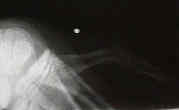- SH Type II Frxs:
- most common frx in proximal phalanx in pediatric population;
- physeal frx occurs due to the proximal attachment of the collateral ligament;
- typically the digit has an abducted angulated
- some residual lateral angulation in SH II fractures may be acceptable in the MP joint (since some remodeling can be expected and since the MP joint allows side to side motion);
- residual angulation in the middle phalanx should not be accepted, since little or no remodeling will occur and since there is no side to side motion at the PIP joint;
- Reduction:
- perform standard ulnar nerve block;
- reduction is achieved by apply traction, flexing MP joint (which stabilizes proximal digit) and then adducting the distal phalanx;
- "pencil method of reduction:"
- some authors recommend facilitating reduction by placing a pencil in the web space and adducting the finger;
- other authors point out that this method of reduction is illogical, since the web space is acutally distal to the fracture site;
- Immobilization:
- place rolled cotton between the little and ring finger and apply buddy tape;
- this will keep an adduction force on the injured phalanx;
- place hand in an ulnar gutter cast w/ the fingers straight





